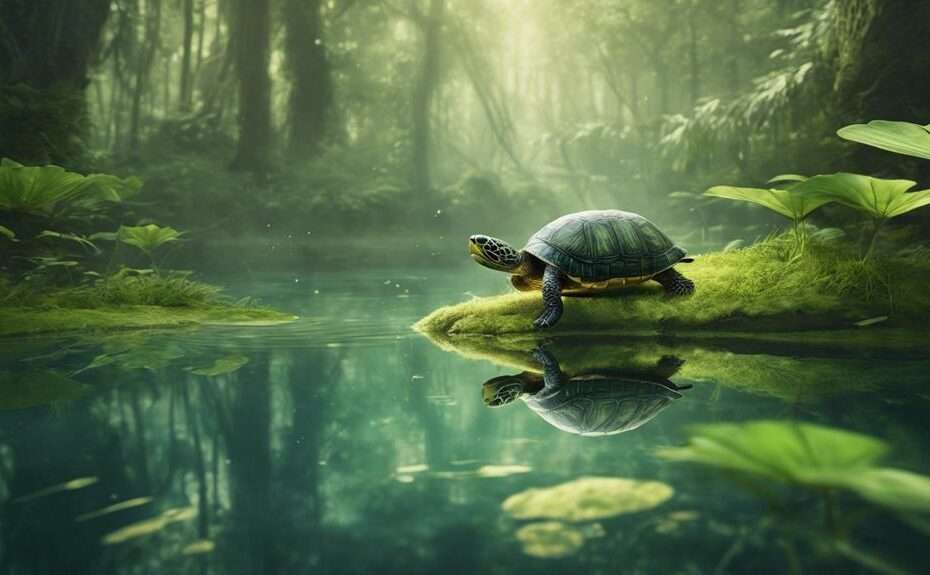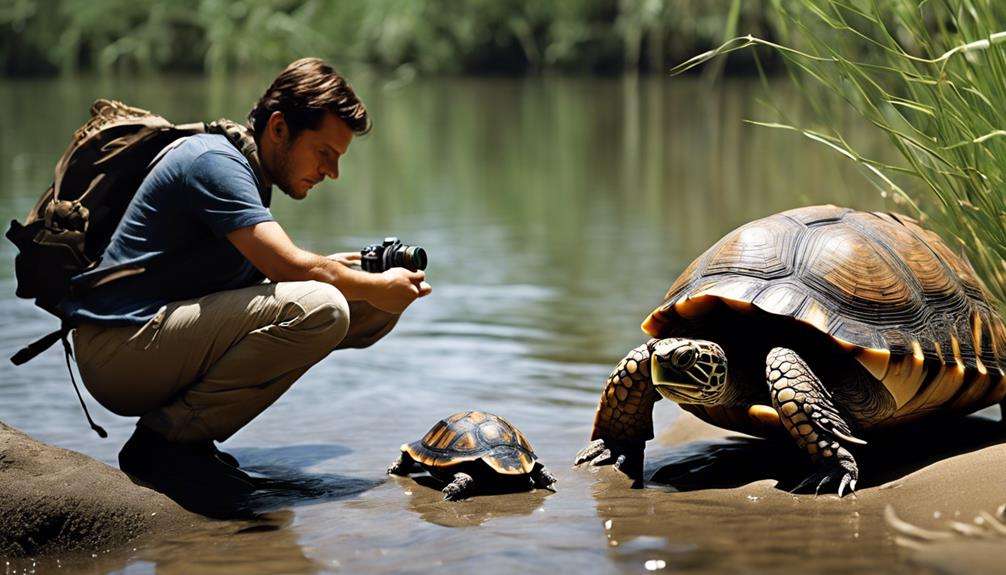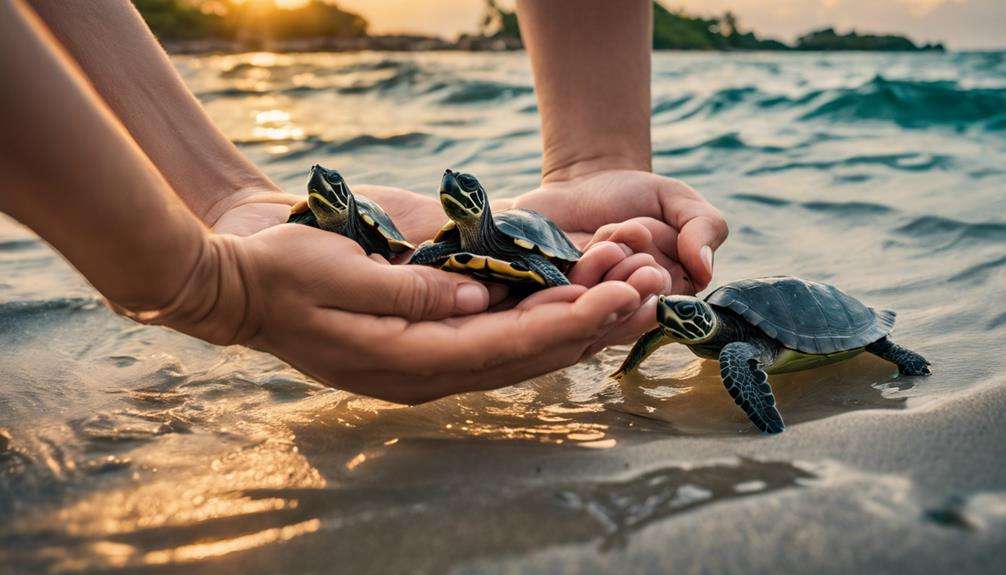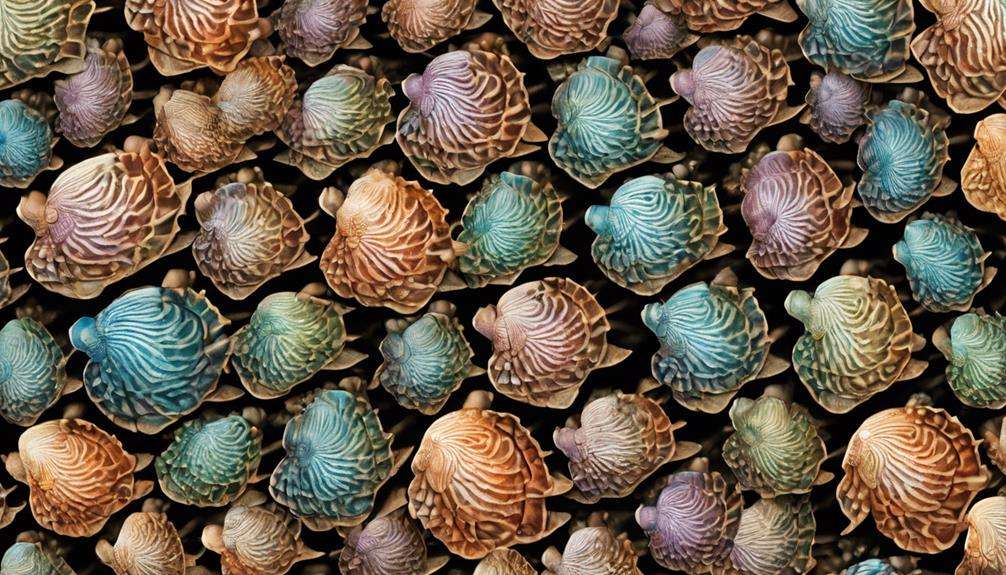You may have marveled at the diversity of turtle species, yet some are noticeably scarce in their natural habitats. Have you ever wondered why certain turtle populations struggle to thrive in the wild?
The reasons behind their rarity are multifaceted, involving a complex interplay of environmental, human-induced, and ecological factors. From habitat destruction to predation pressures and emerging diseases, the challenges these turtles face are compelling.
But what specific threats are pushing these species towards endangerment, and what can be done to reverse this trend?
Key Takeaways
- Habitat degradation and fragmentation reduce essential resources and isolate turtle populations.
- Overexploitation and trade drive vulnerable species closer to extinction.
- Climate change impacts nesting sites, food availability, and migration routes.
- Invasive species and pollution threaten native turtle populations, affecting survival and reproduction.
Habitat Loss and Fragmentation
Habitat loss and fragmentation significantly impact the rarity of certain turtle species in the wild due to human activities like deforestation and urban development. The destruction of nesting sites and foraging areas directly affects the availability of essential resources for uncommon turtle species. This loss disrupts the delicate balance required for their survival. Fragmentation of habitats isolates turtle populations, leading to reduced genetic diversity and an increased risk of extinction. The barriers created by human-induced habitat alterations, such as dam construction and agricultural expansion, further exacerbate the rarity of these turtle species by limiting their movement and dispersal.
To address the challenges posed by habitat loss and fragmentation, conservation efforts must focus on restoring and protecting critical turtle habitats. Implementing measures like creating wildlife corridors and establishing protected areas can help reconnect fragmented habitats and promote gene flow among isolated turtle populations. Additionally, sustainable land-use practices and habitat restoration initiatives are vital in ensuring the long-term survival of uncommon turtle species facing these threats in the wild.
Overexploitation for Trade
The decline of some turtle species in the wild is greatly influenced by their overexploitation for trade, a practice driven by high demand for exotic species in the pet market and illegal activities like poaching and smuggling. This overexploitation for trade poses a significant threat to the survival of various turtle populations globally. Illegal trade activities exacerbate the situation by pushing already vulnerable species closer to extinction.
The high demand for exotic turtle species fuels this exploitation, as collectors seek rare and unique specimens to satisfy market demands. Poaching and smuggling of these turtles further compound the issue, disrupting ecosystems and populations. The unsustainable harvesting of turtles for traditional medicine and food consumption also plays a role in their rarity in the wild.
Efforts to combat overexploitation for trade include stricter enforcement of wildlife protection laws, monitoring and regulating the exotic pet trade, raising awareness about the impacts of illegal trade activities, and promoting sustainable practices. By addressing these key factors, we can work towards preserving the diversity and abundance of turtle species in their natural habitats.
Climate Change Effects
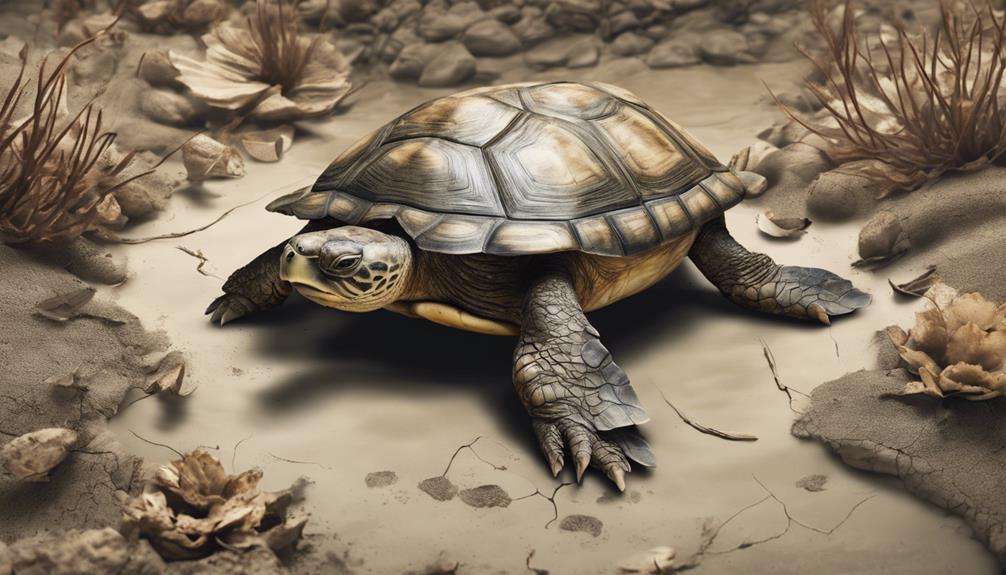
Climate change poses significant threats to uncommon turtle species in the wild, impacting their habitats and altering important nesting sites.
Rising temperatures can lead to imbalanced demographics due to skewed sex ratios in turtle populations, while sea level rise poses a threat to coastal nesting areas essential for reproduction.
Extreme weather events like hurricanes further exacerbate these challenges by destroying turtle nests and disrupting breeding cycles.
Habitat Loss
How do changes in environmental conditions affect the survival of uncommon turtle species in the wild?
Habitat loss, driven by climate change, plays a critical role in the decline of specific turtle species. Rising sea levels, altered precipitation patterns, and temperature shifts directly impact turtle habitats, leading to changes in nesting sites, food availability, and water quality.
Fragmentation of habitats and disruption of migration routes further exacerbate the challenges faced by these turtle populations. The limited adaptive capacity of certain turtle species makes them especially vulnerable to the adverse effects of climate change-induced habitat loss.
Conservation efforts focusing on habitat restoration, protection of critical nesting sites, and sustainable land use practices are essential to mitigate the impacts of habitat loss on these uncommon turtle species.
Temperature Shifts
Temperature shifts resulting from climate change can have significant impacts on uncommon turtle species. These shifts disrupt nesting behaviors and influence hatchling development. Fluctuations in temperature can alter traditional nesting sites, affecting egg incubation and hatchling emergence. Moreover, temperature variations play a crucial role in determining the sex ratios of hatchlings. Increased temperatures can skew these ratios, potentially leading to imbalances within populations. To mitigate these effects, conservation efforts must prioritize preserving and restoring critical nesting habitats, implementing monitoring programs, and addressing broader climate change issues. By taking proactive measures, we can safeguard the future of vulnerable turtle species.
Invasive Species Competition
Competition from invasive species such as rats, pigs, and mongooses poses a significant threat to native turtle populations in their natural habitats. These invasive species compete with native turtles for resources and nesting sites, leading to habitat degradation. Limited access to food and breeding sites due to competition can result in declines in native turtle populations. Additionally, invasive predators target turtle eggs, hatchlings, and adults, impacting their survival and reproduction rates.
To address this issue, control and eradication efforts against invasive species are important. By implementing measures to manage invasive populations, vulnerable turtle species can be protected from further population declines and potential extinctions. The presence of invasive species disrupts the delicate balance of ecosystems, directly affecting the overall biodiversity and survival of native turtle populations.
It's imperative to prioritize conservation efforts that focus on mitigating the impacts of invasive species on native turtles to safeguard their long-term survival in the wild.
Pollution and Contamination Impacts
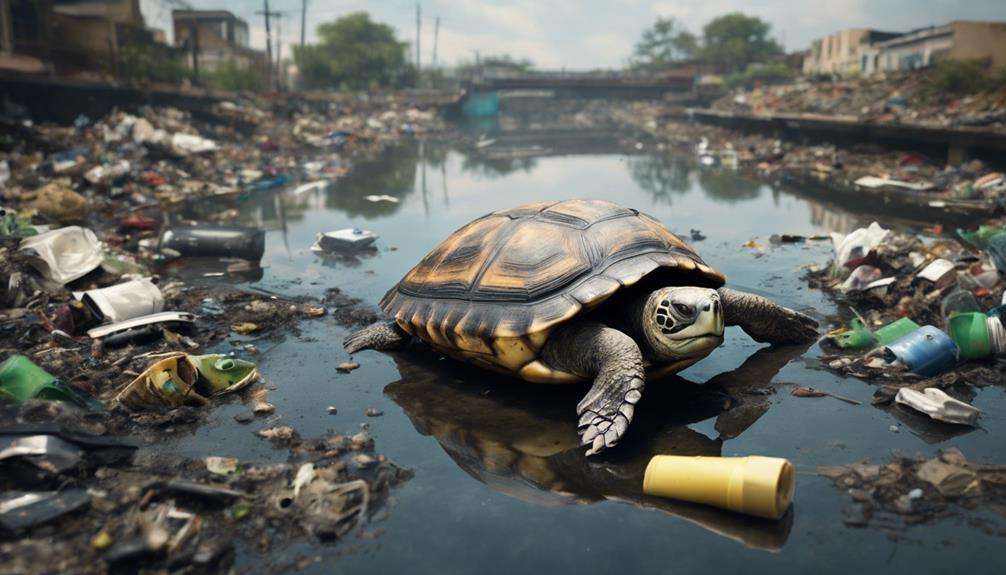
Pollution stemming from human activities like industrial processes and agriculture runoff has been shown to greatly deteriorate water quality in turtle habitats.
The contamination of these environments with chemicals such as pesticides and heavy metals poses grave dangers to turtle populations.
It's important to address these issues to safeguard the well-being and survival of these uncommon turtle species in the wild.
Water Pollution Effects
Contaminants from various sources, such as chemicals, heavy metals, and toxins, can greatly impact the habitats of uncommon turtle species in the wild. Water pollution poses a significant threat to endangered turtles by contaminating their environments and disrupting their ecosystems.
Polluted water bodies can decrease food availability for these turtles, directly affecting their survival and reproductive success. Pesticides, industrial waste, and plastic debris further exacerbate the issue, leading to population declines and health problems among turtle species. Diseases linked to polluted waters can escalate mortality rates in these vulnerable populations.
To safeguard rare turtle species and preserve aquatic ecosystems, urgent actions to mitigate water pollution are imperative.
Habitat Contamination Dangers
The detrimental effects of habitat contamination on uncommon turtle species in the wild are profound, with pollutants like chemicals, plastics, and oil spills posing serious risks to their survival and ecosystem health. Pollution can lead to habitat degradation, reducing water quality and altering food sources important for these turtles.
Contamination impacts include the accumulation of heavy metals, pesticides, and microplastics in their bodies, affecting overall health and reproductive success. Oil spills present a significant threat by coating turtles' shells, disrupting their ability to regulate body temperature and causing long-term health issues.
These habitat contamination dangers not only harm individual turtles but also disrupt entire ecosystems, leading to declines in prey availability and disturbing the delicate balance of turtle habitats. Addressing pollution is critical to safeguarding these vulnerable turtle species.
Human Activities Harm
Human activities significantly impact aquatic habitats for turtle species in the wild through the release of various pollutants. Pollution from industrial activities, agriculture, and urban development introduces contaminants like heavy metals, pesticides, and plastic waste into water bodies, affecting turtle habitats. These contaminants accumulate, causing health issues and reproductive challenges among turtle populations.
Oil spills and chemical leaks pose immediate threats, leading to direct mortality and long-term impacts on food sources. Runoff from roads and construction sites disrupts ecosystems where turtles reside, altering water chemistry and reducing biodiversity. Additionally, the presence of contaminated sediments in aquatic environments further affects turtle nesting sites, egg development, and overall reproductive success.
Addressing pollution and habitat disruption is essential to safeguard the habitats of uncommon turtle species in the wild.
Disease and Pathogen Outbreaks
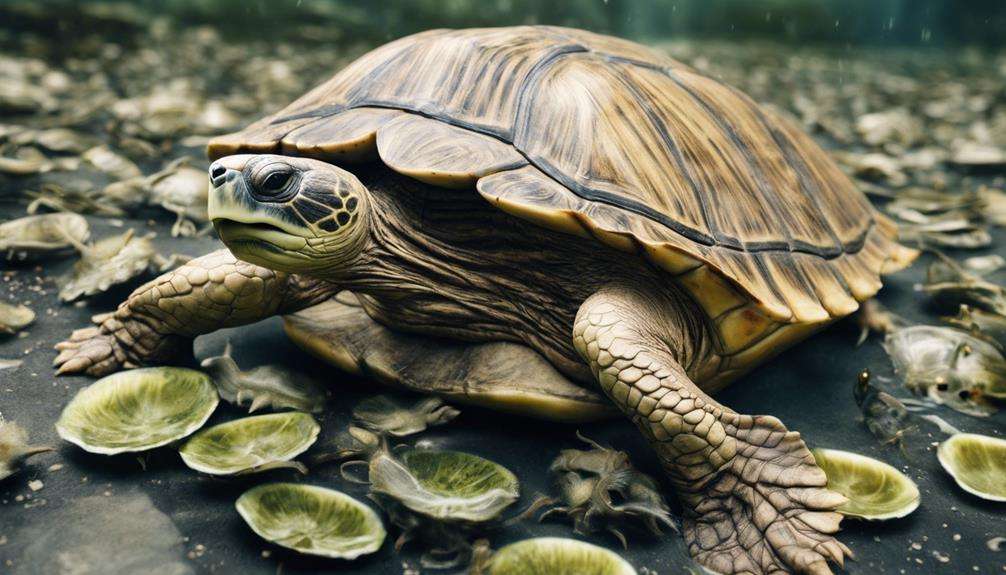
Disease outbreaks pose a significant threat to uncommon turtle species in the wild, impacting their survival and population numbers. Pathogens such as Mycoplasma agassizii and M. testudineum are known to cause upper respiratory tract disease in turtles, leading to severe consequences for affected populations.
These outbreaks can be particularly devastating in conjunction with stressors like habitat loss, pollution, and overcrowding. The rapid spread of diseases within dense turtle populations can result in high mortality rates in localized areas, further endangering these already vulnerable species.
Factors such as habitat degradation and human activities have been linked to the increased prevalence of disease outbreaks in turtle populations. To address this issue, conservation efforts should focus on reducing stressors like habitat loss, implementing disease monitoring programs, and promoting wildlife rehabilitation initiatives to mitigate the impact of disease outbreaks on uncommon turtle species in the wild.
Reproductive Challenges and Nest Predation
Facing reproductive challenges and nest predation, uncommon turtle species in the wild encounter hurdles that impact their population sustainability and breeding success. High nest predation rates, where eggs and hatchlings fall prey to various predators, contribute notably to the rarity of these turtle species.
Factors such as limited nesting sites, low egg survival rates, and vulnerability during hatching further compound the reproductive challenges faced by these species. Nest predation, often by mammals, birds, and other reptiles, poses a noteworthy threat to successful reproduction and population growth. This threat is exacerbated by habitat fragmentation, human disturbance, and climate change, increasing pressure on already vulnerable turtle populations.
To address these challenges, conservation efforts must focus on nest protection, predator control, and habitat restoration. By safeguarding nesting sites, managing predator populations, and mitigating human impacts on habitats, we can support the recovery of uncommon turtle species. Implementing targeted conservation strategies is essential for ensuring the long-term viability and sustainability of these at-risk turtle populations.
Frequently Asked Questions
What Is the Rarest Species of Turtle?
The rarest species of turtle is the Yangtze Giant Softshell Turtle, with only 3 individuals left in the wild. Conservation efforts are crucial due to habitat destruction, pollution, and illegal trade threatening their existence.
What Turtle Is Almost Extinct?
The Yangtze Giant Softshell Turtle is almost extinct due to habitat loss, poaching, and pollution. Protection efforts involve captive breeding and habitat preservation. Without intervention, this species faces extinction, impacting its ecosystem in China and Vietnam.
Why Are Turtles Endangered Species?
When turtles face danger, it's often due to illegal poaching, habitat destruction, and pollution. These factors threaten their existence. Conservation efforts are crucial to safeguard these endangered species, ensuring their survival for future generations.
What Turtle Species Is Not Endangered?
The Eastern Box Turtle, not endangered, thrives in diverse habitats. Its stable population trend benefits from conservation efforts focusing on habitat protection. Recognizable by shell patterns, this species' terrestrial habits guarantee continued presence in the wild.
Conclusion
To guarantee the survival of uncommon turtle species in the wild, it's crucial to address the various threats they face. These threats include habitat loss, overexploitation, climate change, invasive species, pollution, and disease.
Conservation efforts must focus on protecting remaining habitats, engaging local communities, and implementing sustainable practices. By understanding and addressing these challenges, we can work towards a future where these unique turtle species can thrive and contribute to the biodiversity of our planet.
